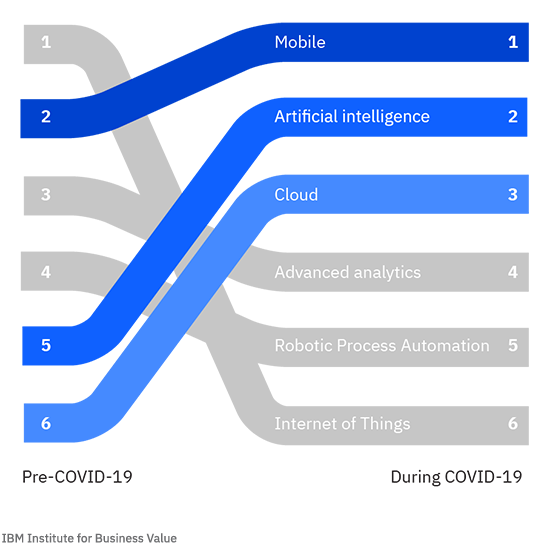Sixty percent of business leaders are accelerating their digital transformation efforts as a result of COVID-19. This, in itself, is not really news or surprising. We understand how a world in lockdown, where movements are limited, needs to rely heavily on technology to continue operating. Public and business models are fast evolving to become more digital and ubiquitous.
As I was working to define and ramp-up the IBM response to COVID-19, I wanted to understand which technologies are making a real difference among companies that are faring relatively well during this crisis and companies that are not. This would help us better guide our clients to technologies that may offer them the most significant benefits. I thought approaching this question by industry and comparing across industries might give us some new and interesting insights, as there are many complex factors at play within each given sector of the economy.
Obviously, it’s not all about technology. Our research shows that for six of the 18 industries we analyzed, you can’t really detect any strong correlation between technology footprint and financial performance. Indeed, industry performance has been influenced by many external factors, such stay-at-home orders, travel restrictions, and supply chain disruptions, among others.
But what our research reveals is that there is a massive increase in the direct correlation between technology adoption and financial performance during COVID-19 compared to the past three years. Prior to recent events, there were only a few industries in which these exponential technologies played a significant role in financial performance.
Results are striking. In 12 industries, leaders in technology adoption outperformed their less-advanced peers by an average of 6 percentage points and as much as 16 percentage points in revenue performance. Industries are seeing the effects of their technology choices in their financial performance.
For example, differentiation has been high in retail this year. Those in the top 10 percent of technology adoption have outperformed the remaining 90 percent on revenue growth by 16 percentage points. For a typical $10 billion revenue company, this is equivalent to a revenue premium for high-technology adopters of $1.6 billion annually.
Our research also reveals that the relative weight and influence of certain technologies on performance has changed dramatically. We are talking about a shift of the technology mix that underpins performance by providing greater resiliency, agility, and speed. In particular, adoption of cloud and AI have become significantly larger contributors to improved financial performance since the onset of COVID-19.

The mix has changed overall, but we could also determine that each industry has a unique “fingerprint” for key technologies. The technologies that benefit one industry are not always differentiating for another. Companies that have invested in the right mix of industry-specific key technologies have gained a significant revenue premium during the current crisis.
Of course, we’re highly focused on the pandemic right now. However, it is by no means the only economic risk facing businesses today. There are significant global political and environmental risks and challenges that may need to be addressed at any time. And other pandemics remain an ongoing possibility. Organizations that adapt to COVID-19 with speed, agility, and resilience are likely to be well positioned to meet other sudden challenges.
Until now, leaders were likely unaware of the fingerprint of technologies that lend advantage to each industry. So, while digital transformation efforts have continued, they may not have been aimed at the best targets. This initial research starts addressing this issue and provide a macro-compass to business leaders in their respective fields of activity.
The next normal is being shaped right now. It calls for leaders to step back and make some critical shifts and decisions to redefine or significantly adjust their enterprises to this new reality. Some leaders are responding faster to challenges and opportunities by accelerating their business transformation. They seize the potential of digital technologies to shape business and operating models for the future, applying these new technologies in conjunction with their historic strengths to reshape their competitive positions.
We call this journey the path to a revolutionary, next-generation business model “The Cognitive Enterprise.”
Our new report, “Digital acceleration: Top technologies driving growth in a time of crisis,” provides specifics on our detailed research. It explains how particular technologies can be applied to six core capabilities that are helping industries navigate the pandemic and emerge stronger in a post-pandemic world
As we say in the report: “Realizing the vision requires immediate action.” The report can help you identify the differentiating technologies being used by leaders in your industry, and where to apply your digital transformation to optimize them.
Meet the author


